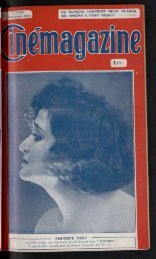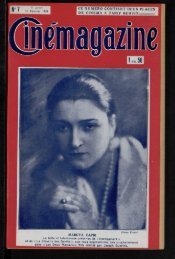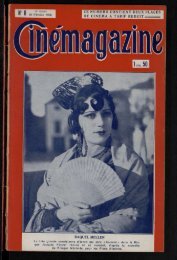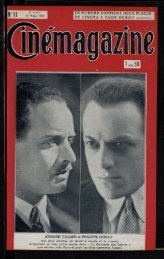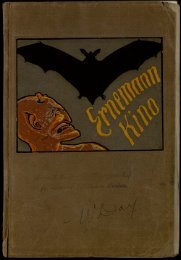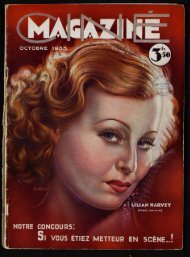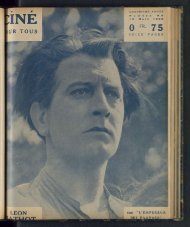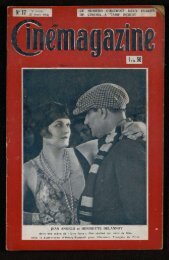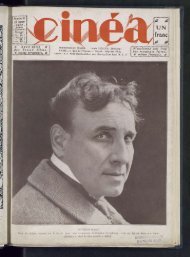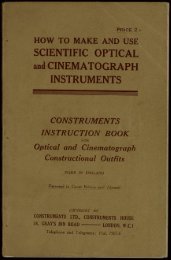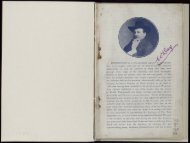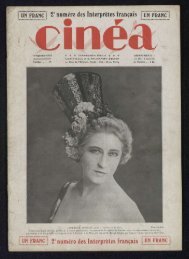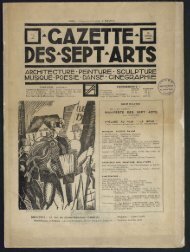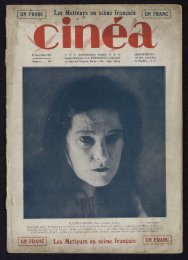Untitled
Untitled
Untitled
Create successful ePaper yourself
Turn your PDF publications into a flip-book with our unique Google optimized e-Paper software.
CHAPTER XIII.<br />
ilboving %libes anb Effect.<br />
UNDER this title fall a large number of more or less<br />
elaborate devices intended to enhance the beauty or realism,<br />
or both, of projected pictures. Almost all effects require at<br />
the least two lanterns, some needing three and even more.<br />
There are a few, however, which can be exhibited by means<br />
of a single lantern, and these will be considered first.<br />
It is difficult to assign a reason for the decadence of<br />
lantern exhibitions which has undoubtedly taken place in<br />
the last few years. Signs of it are seen even in displays<br />
confined to plain photographic slides, the average of which<br />
is in quality markedly inferior to what it was ten, or even<br />
five years since. But in " effects,"- the falling-off has been<br />
very much more marked, and of displays such as used to be<br />
given at the Polytechnic and elsewhere, there are now none.<br />
It is to this change of fashion, or whatever else it may be<br />
called, that we must look for the origin of a certain amount<br />
of contempt felt by many lanternists for "effects," due<br />
doubtless to the substitution for the old displays, of inferior<br />
slides with bungling and incompetent exhibitors. The<br />
popularity of the photographic slide, which does not lend<br />
itself, or rather which has not been adapted to "effects " as<br />
much as is possible, has something to do with the matter.<br />
Still, as many of these illusions are among the finest things<br />
that can be shown with the lantern, are marvels of<br />
ingenuity and skill, and are still popular with some<br />
audiences, they cannot be altogether ignored.<br />
MOVING SLIDES AND EFFECTS.<br />
The panoramic slide, as its name implies, is one which<br />
depicts a wide expanse of scenery, the shape of the picture<br />
being long and narrow ; the slide is gradually pushed<br />
through the lantern, only a portion of it being seen at any<br />
one time. A modification has been suggested, to get over<br />
the liability to breakage inherent in such<br />
79<br />
lengthy slides, in<br />
the shape of a roll of transparent film, bearing the picture,<br />
which is gradually wound off one roller on to another, as in<br />
the photographic roll-holder.<br />
Lever slides are constructed of two separate<br />
glasses, one<br />
fixed in the frame, the other capable of being partially<br />
revolved while in the lantern by means of a lever. A<br />
favourite subject for these is a cow standing in a pool, the<br />
cow, minus its head, and the pool being painted on the fixed<br />
glass. The cow's head being on the movable glass, on<br />
shifting the lever, the cow appears to lower her head to<br />
drink. Other subjects for this class of slide, which is best<br />
adapted for juvenile audiences, are children see-sawing,<br />
cobblers nailing, drummers, etc. In lever slides, as indeed<br />
in all slides where more than one glass is employed, the<br />
picture must be on the two inner surfaces, which are as close<br />
together as practicable, without touching, otherwise it will<br />
not be possible to get the two into focus at the same time.<br />
Slipping slides, which also are more suitable for children's<br />
entertainments, are likewise constructed of more than one<br />
glass. In these, however, one of the glasses slides along in<br />
front of the other, and either covers and uncovers some part<br />
of the scene in so doing, or removes some portion and<br />
substitutes something else.<br />
Tinters consist of coloured glasses which can be slipped over<br />
in front of the objective, so as to give any particular slide a<br />
general colour. They are most effective with slides of<br />
statuary and similar subjects blocked out so as to stand out<br />
against a black background, and in using them care should<br />
be taken that the tint is not too deep, a frequent error.<br />
Of all types of mechanical slide, however, the chromatrope,<br />
as it is called, is the highest. In this, two circular glasses<br />
bearing geometrical designs are rotated in opposite directions<br />
while in the lantern. One design crossing another in<br />
this way can be made most effective, and it will be found



